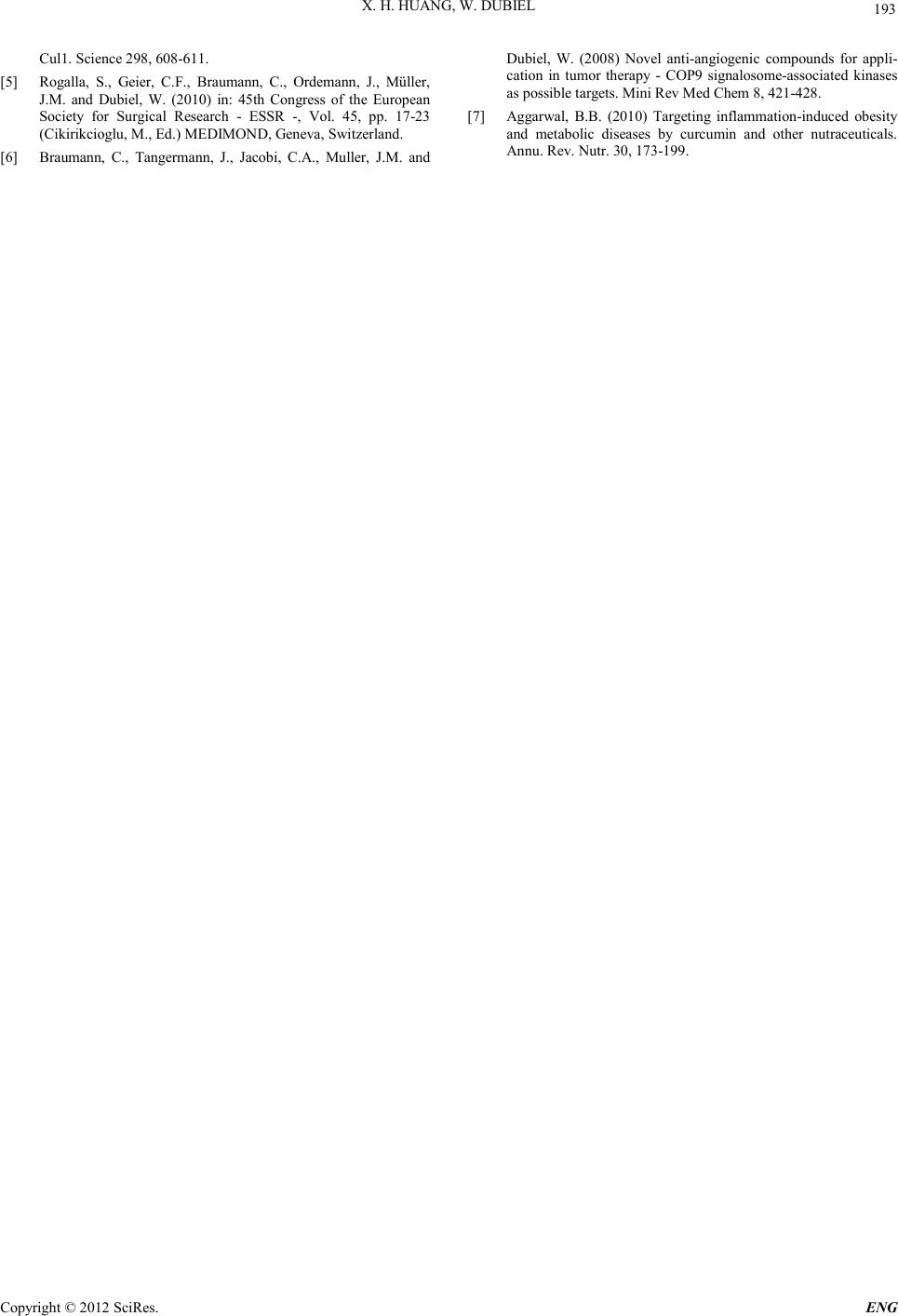Paper Menu >>
Journal Menu >>
 Engineering, 2012, 5, 192-193 doi:10.4236/eng.2012.410B050 Published Online October 2012 (http://www.SciRP.org/journal/eng) Copyright © 2012 SciRes. ENG The COP9 Signalosome Controls Adipocyte Differentiation by Regulating CHOP Protein Stability Xiaohua Huang, Wolfgang D u b ie l Department of General, Visceral, Vascular and Thoracic Surgery, Division of Molecular Biology, Charité - Universitätsmedizin Berlin, Berlin, Germany Email: Xiaohua.huang@charite.de, Wolfgang.dubiel@charite.de Received 2012 ABSTRACT Obesity is a serious health problem of our time. Dysfunction of adipogenesis, the differentiation of adipocytes, is a hallmark of obes- ity. Therefore her e we investigate the role of the COP9 signalosome and of CHOP in the differentiation of LiSa-2 preadipocytes. Keywords: COP9 Signalosome; CHOP; Adipogenesis; Cullin-RING Ubiquitin Ligase 1. Introduction Adipogenesis (differentiation of adipocytes) is a highly com- plex mechanism, closely cross-linked to the induction of an- giogenesis which in turn promotes preadipocyte differentiation. Dysfunction of adipogenesis causes obesity. The process of adipogenesis is regulated by an elaborate network of transcrip- tion factors that coordinate the expression of hundreds of pro- teins responsible for establishing fat cell phenotype. In the cen- tre of that network are the two master regulators of adipocyte differentiation, the peroxisome proliferator-activated receptor γ (PPAR-γ) and CCAAT/enhancer binding protein α (C/EBPα). Besides P PAR-γ, C/EBPα is considered a primary transcription factor that mediates adipogenesis. Early in the differentiation program C/EBPβ is expressed, which is the transcriptional ac- tivator of PPAR-γ and C/EBPα. Its activity is delayed by the C/EBP homologous protein (CHOP, also called growth ar- rest-DNA damage-induced 153, GADD153), a dominant nega- tive form of C/EBP family members. CHOP dimerizes with adipogenic C/EBPs, suppresses their transactivation activity and, therefore, blocks adipogenesis. CHOP has to be down-regulated for the progression of the differentiation pro- gram. Interestingly, CHOP protein is degraded by the ubiquitin (Ub) proteasome system (UPS) and proteasome inhibitors sta- bilize the protein and block adipocyte differentiation [1]. 2. Results he COP9 signalosome (CSN) was first discovered in 1994 as a protein complex which negatively regulates photomorpho- genesis in Arabidopsis [2]. It consists of 8 subunits (CSN1-8; depending on their size) and was detected in all eukaryoti c cells . The CSN exhibits an extensive range of biological responses including embryonic development, cell cycle, signal transduc- tion, apoptosis, DNA repair, homeostasis and also angiogenesis - all together reflecting the multifunctionality of the complex. The most important function of the CSN is the regulation of the activity of cullin-RING E3 Ub-ligases (CRLs) [3]. These li- gases are the prominent transducers for protein degradation mediating the formation of a complex composed of the Ub carrying E2 conjugating enzyme and the substrate which is to be ubiquitinated. The CSN5 subunit of the CSN exhibits a met- alloprotease activity, which can remove Nedd8 from CRLs, which regulates their activity [4]. Recently we have shown that the CSN is involved in adipo- genesis [5]. Inhibitors of CSN associated kinases such curcu- min and curcumin-like substances block the production of VEGF in tumor cells [6] as well as in adipocytes [5]. Inhibition of adipocyte VEGF production is one explanation for the fact that obesity can be downregulated by curcumin and resveratrol [7], although t he exact mechanism remained obscure. Here we show that the curcumin-like compound piceatannol induces CHOP in LiSa-2 preadipocytes, which blocks the process of adipocyte differentiation. CHOP is targeted for de- gradation via UPS by the CSN and permanent downregulation of the CSN in LiSa-2 cells inhibits adipogenesis by stabilizing CHOP . Permanent overexpres sion of Flag-CHOP causes a sim- ilar phenotype as downregulation of the CSN. The CRL re- sponsible for CHOP Ubiquitination was identified. 3. Conclusions CHOP is an important regulator of adipogenesis. The COP9 signalosome is essential for the differentiation of adipocytes. REFERENCES [1] Li, X. et al. (2006) Lactacystin inhib its 3T3 -L1 adipocyte differ- entiation through induction of CHOP-10 expression. Biochem. Biophys. Res. Commun. 350, 1-6. [2] Wei, N., Chamovitz, D.A. and Deng, X.W. (1994) Arabidopsis COP9 is a component of a novel signaling complex mediating light control of development. Cell 78, 117 -124. [3] Deshaies, R.J. and Joazeiro, C.A. (2009) RING domain E3 ubiq- uitin ligas es. Annu. R ev. Biochem. 78, 399-434. [4] Cope, G.A., Suh, G.S., Aravind, L., Schwarz, S.E., Zipursky, S.L., Koonin, E.V. and Deshaies, R.J. (2002) Role of predicted metalloprotease motif of Jab1/Csn5 in cleavage of Nedd8 from  X. H. HUANG, W. DUBIEL Copyright © 2012 SciRes. E NG 193 Cu l 1. Science 298, 6 0 8-611. [5] Rogalla, S., Geier, C.F., Braumann, C., Ordemann, J., Müller, J.M. and Dubiel, W. (2010) in: 45th Congress of the European Society for Surgical Research - ESSR -, Vol. 45, pp. 17-23 (Cikirikcioglu, M., Ed.) MEDIMOND, Geneva, Switzerland. [6] Braumann, C., Tangermann, J., Jacobi, C.A., Muller, J.M. and Dubiel, W. (2008) Novel anti-angiogenic compounds for appli- cation in tumor therapy - COP9 signalosome-associated kinases as possible targ ets. Mini Rev Med C hem 8, 421 -428. [7] Aggarwal, B.B. (2010) Targeting inflammation-induced obesity and metabolic diseases by curcumin and other nutraceuticals. Annu. Rev . Nu t r . 30, 1 73-199. |

